A Comprehensive Guide to Wildfire Survival: Best Ways to Survive — expert tips and practical strategies to protect yourself, your family, and your home.
Wildfires are unpredictable, fast-moving, and dangerous—but being prepared can make all the difference. A Comprehensive Guide to Wildfire Survival: Best Ways to Survive is your roadmap for staying safe when flames are near. From creating defensible space around your home to building an emergency evacuation plan, I’ll share the strategies and lessons I’ve learned firsthand. This guide isn’t about fear—it’s about knowledge, preparation, and peace of mind. With the right plan and gear, you can face wildfire season with confidence.
This is a pinnable post. Tap or hover over any image in this post to pin to your Pinterest Boards.
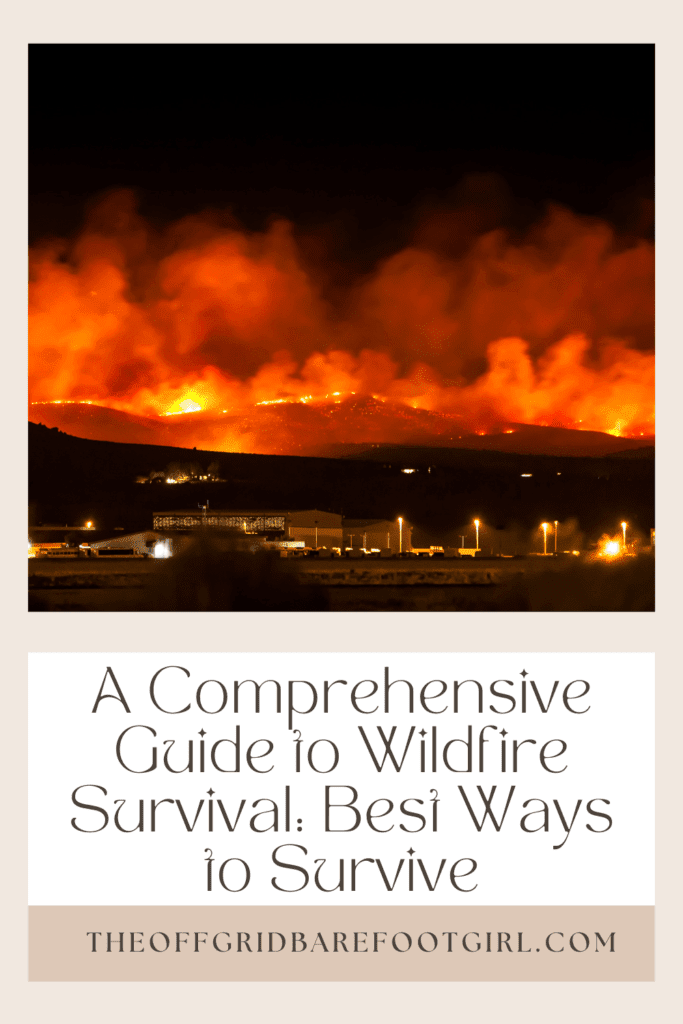
Wildfire Survival
Wildfire survival refers to the strategies and preparations individuals can take to protect themselves and their property during a wildfire. Preparing is crucial as wildfires can spread quickly and pose a significant risk to lives and homes. Understanding the key factors to consider in wildfire survival can make a significant difference in the outcome of such an event.
Every summer in my area, I watch in horror as the news footage spreads images and video footage of my state, along with many other states, burning across the land. Firefighters and authorities battle against the rage of the flames as it burns up our homeland. This post burns a hole in my heart, and I felt the need to help spread the knowledge of how we can help fight and protect ourselves and learn a little bit more about wildfire survival.
Preparing for a Wildfire
Creating a defensible space around your home can help protect it from wildfires. You can do this by clearing vegetation, leaves, and debris within at least 30 feet of your home, trimming tree branches that hang over your roof or are close to the ground, and using fire-resistant materials when constructing or renovating your home.
Regularly removing dry leaves, dead plants, and fallen branches from your yard can also reduce the risk of fires spreading to your home. Maintaining a distance of at least 10 feet between trees and shrubs and keeping your gutters clean from debris that could ignite during a wildfire can further enhance your home’s defensibility.
Protect vulnerable areas of your home by covering vents and openings with fine mesh screens to prevent embers from entering. Enclose the area under decks and porches with fire-resistant materials and install spark arresters on chimneys and stovepipes to prevent sparks from escaping. Choose fire-resistant roofing materials such as metal, tile, or asphalt shingles, and use non-combustible siding materials like brick, stucco, or cement. If possible, replace flammable fences with metal or rock walls.
Emergency Survival Kit
Having an emergency survival kit on hand can be crucial during a wildfire. Your kit should include non-perishable food and at least three days’ supply of water per person, a battery-powered or hand-cranked radio to stay updated on wildfire developments, flashlights, extra batteries, and a first aid kit.
Choose foods that do not require refrigeration or cooking, such as canned goods and energy bars. Store water in a cool, dark place in sturdy containers and keep a supply of necessary medications for each family member. Your first aid kit should include bandages, antiseptic ointment, pain relievers, and any necessary prescription medications.
Make sure to have copies of important documents like identification, insurance policies, and medical records in a waterproof container. Also, keep a list of emergency contact numbers. For pet owners, prepare a pet emergency kit with food, water, medications, and comfort items. Ensure pets have identification tags and are microchipped. Have a plan for their evacuation or sheltering in case of a wildfire.
For further reading, learn more about What Should Be in A 72-Hour Survival Kit?
Staying Informed and Evacuation
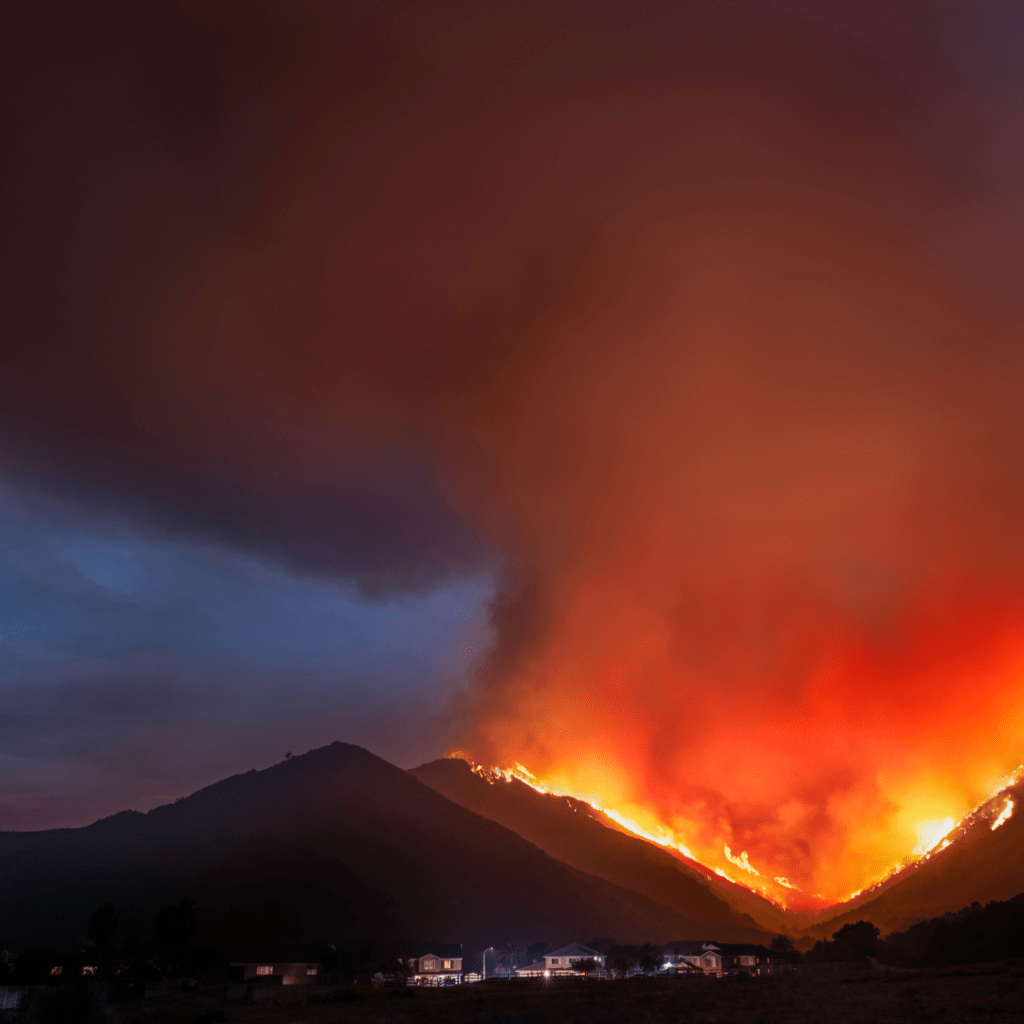
Staying informed about wildfire updates and evacuation orders can be lifesaving. Sign up for emergency alerts and notifications from local authorities, download wildfire tracking apps or use websites that provide real-time information, and follow the social media accounts of local fire departments and emergency management agencies.
Stay tuned to local news stations and radio channels for the latest information on wildfires. Pay close attention to evacuation orders and follow the instructions given by authorities. Have a designated meeting place for your family in case of separation during an evacuation.
Identify multiple evacuation routes from your home and the surrounding areas. Consider alternative ways in case of road closures or congestion. Have a map and directions prepared in case you lose access to GPS or mobile data. In a portable bag, prepare a “go bag” with essential items such as clothing, toiletries, and important documents. Include a few days’ worth of food and water, a first aid kit, and any necessary medications. Keep the go bag in an easily accessible location.
What to Do During a Wildfire
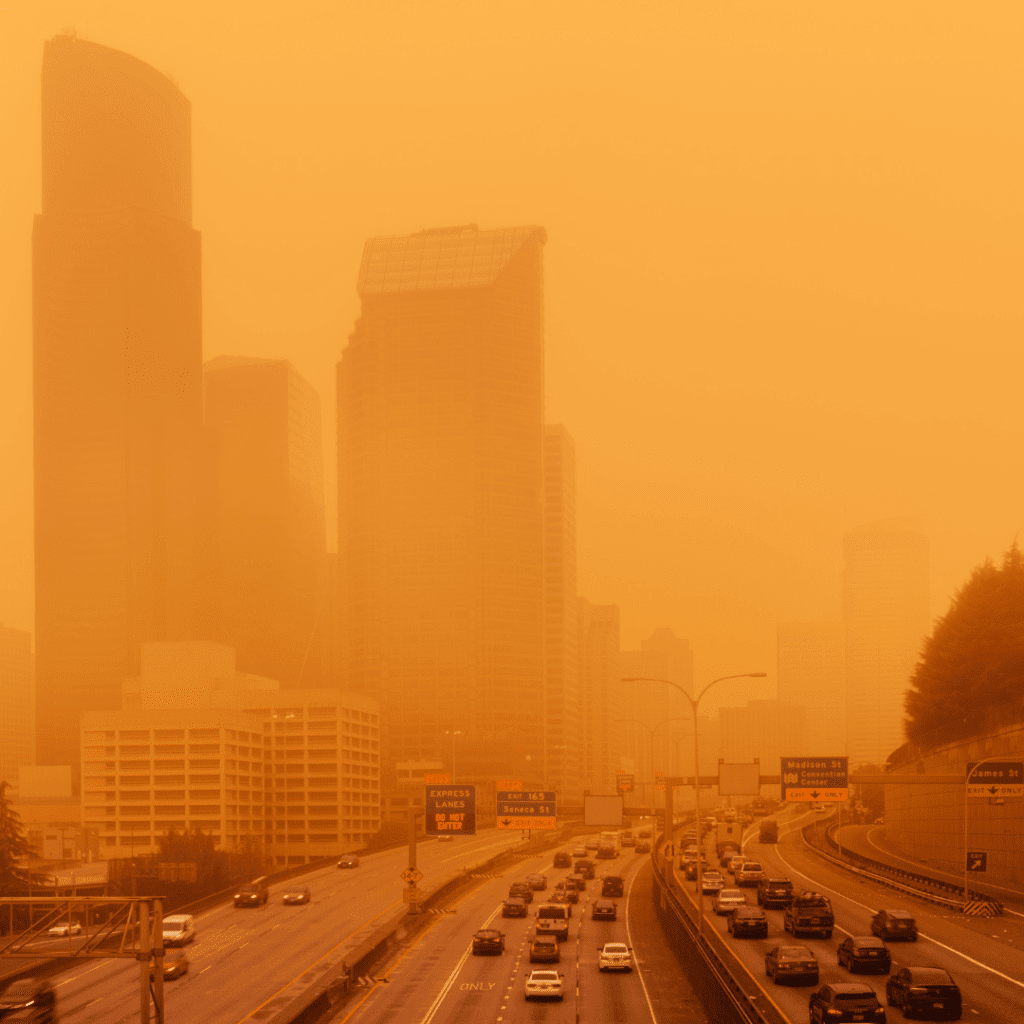
If you are instructed to evacuate by authorities, leave immediately. Follow designated evacuation routes and do not take shortcuts. Inform family members and friends about your evacuation plans. Choose routes away from the path of the fire and towards safe areas. Avoid areas with dense vegetation or narrow roads that may impede your evacuation. Stay aware of changes in wind direction that could affect the fire’s path.
If you become trapped during a wildfire, seek shelter inside a building, preferably with a fire-resistant design. Close all windows and doors to prevent smoke and embers from entering. Fill sinks and bathtubs with water as an additional source for firefighting if needed.
To minimize smoke inhalation during a wildfire, stay low to the ground, as smoke rises and the air closer to the floor is cleaner. Cover your nose and mouth with a damp cloth to filter out smoke particles. Avoid physical exertion to minimize the amount of smoke you inhale.
Preventing Wildfires
You can help prevent wildfires by practicing fire-safe habits. Never leave fires unattended and extinguish them completely before leaving. Dispose of cigarette butts in designated containers and never throw them on the ground. Avoid using fireworks or any type of open flame in areas prone to wildfires.
When extinguishing campfires, pour water over the fire and stir the ashes until they are cool to the touch. Make sure the fire pit is completely extinguished and free from any smoldering embers. Follow any local regulations or guidelines regarding campfire safety.
Be cautious when using power tools or machinery that can generate sparks on dry and windy days. Do not park vehicles with hot exhaust systems on dry grass or vegetation. Be mindful of any activities that could potentially ignite a fire, such as welding or burning debris. If you notice any signs of a wildfire or potential fire hazards, report them immediately to the authorities. Be proactive in informing neighbors and community members about fire safety practices. Promote awareness of fire prevention measures through local organizations or community events.
Wildfire Survival and Prevention
Surviving a wildfire involves creating a defensible space around your home, clearing debris and vegetation regularly, preparing an emergency survival kit, staying informed and following evacuation orders, knowing how to react during a wildfire, and taking steps to prevent wildfires. Taking these precautions can significantly increase your chances of protecting your life and property from wildfires. For further information on wildfire survival and prevention, consider additional resources from local fire departments and emergency management agencies.
Creating and Maintaining a Fire-Resistant Landscape
Wildfires pose a significant threat to human lives and property. Creating a fire-resistant landscape around your home can help mitigate this risk. Not only does it enhance the safety of your property, but it also contributes to the overall resilience of your community. Utilizing the correct landscaping techniques can significantly reduce the chances of your home catching fire during a wildfire.
Remove all dead or dry spent plant debris from your garden and property. Keep your area well-raked of litter and dry debris like fallen leaves and dry-mowed grass. Keep a well-mowed and trimmed lawn free of tall dry grass and weeds. Prune all dead branches from trees and bushes to maintain healthy vigorous growth.
Understanding Fire-Resistant Landscapes
A fire-resistant landscape is designed with the primary aim of minimizing the spread of fire and reducing its intensity. Key elements include proper plant selection, strategic plant placement, and the use of fire-resistant materials. These landscapes are designed to create a defensible space around your home, acting as a buffer zone against approaching wildfires. Proper plant selection is crucial, as some plants are more flammable than others. It’s also important to consider maintenance practices that help sustain the landscape’s fire-resistant properties.
Creating a Fire-Resistant Landscape: Actions to Take
Step 1: Assessing the Risk
Your first step should be to evaluate the wildfire risk in your area. This includes considering factors such as proximity to forests, historical fire patterns, and local weather conditions. Identify vulnerable areas around your home, such as overhanging branches, combustible materials, and vegetation close to structures. Consulting with local fire departments or wildfire prevention agencies can provide specific recommendations for your area.
- Evaluate the wildfire risk in your area.
- Consult with local fire departments or wildfire prevention agencies for specific recommendations for your area.
Step 2: Selecting Fire-Resistant Plants
Choose plants that have a high moisture content and low flammability. Examples of fire-resistant plants include succulents, deciduous trees, and native shrubs. Consider the plant’s ability to withstand drought conditions, as water scarcity can increase the risk of wildfires. Avoid highly flammable plants, such as conifers and ornamental grasses. Grouping plants with similar water needs together can create efficient irrigation zones.
Fire-resistant does not mean fireproof. The characteristics of fire-resistant plants include leaves that are moist and tend not to dry out. They contain sap, which is a waterlike substance. Avoid plants that dry out quickly, have fine twigs, leaves, and needles, and have loose, dry bark.
- Choose plants that have a high moisture content and low flammability.
- Fire-resistant plants include succulents, deciduous trees, and native shrubs.
- Plants should withstand drought conditions, as water scarcity can increase the risk of wildfires.
- Avoid highly flammable plants, such as conifers and ornamental grasses.
- Grouping plants with similar water needs together can create efficient irrigation zones.
Step 3: Proper Plant Placement
Strategically place plants to create firebreaks and minimize the spread of fire. Keep vegetation at least 30 feet away from structures to reduce the risk of fire ignition. Create a defensible space by removing dead plants, dry leaves, and other flammable debris from the immediate vicinity of your home. Use non-combustible materials, such as gravel or stone, for pathways and driveways to prevent the spread of fire. Consider the slope of your property when placing plants, as steep slopes can increase the intensity and speed of a wildfire.
- Strategically place plants to create firebreaks and minimize the spread of fire.
- Keep vegetation at least 30 feet away from structures to reduce the risk of fire ignition.
- Create a defensible space by removing dead plants, dry leaves, and other flammable debris from the immediate vicinity of your home.
- Use non-combustible materials, such as gravel or stone, for pathways and driveways to prevent the spread of fire.
- Consider the slope of your property when placing plants, as steep slopes can increase the intensity and speed of a wildfire.
Step 4: Implementing Fire-Resistant Landscaping Techniques
Use fire-resistant materials for hardscaping, such as concrete, brick, or stone. Maintain a proper irrigation system to ensure plants receive adequate water and remain healthy. Regularly prune trees and shrubs to remove dead or overgrown branches, reducing the fuel load for potential fires. Consider installing a fire-resistant roof and using fire-resistant siding materials. Remember to follow local regulations and guidelines for fire-resistant landscaping practices.
- Use fire-resistant materials for hardscaping, such as concrete, brick, or stone.
- Maintain a proper irrigation system to ensure plants receive adequate water and remain healthy.
- Regularly prune trees and shrubs to remove dead or overgrown branches, reducing the fuel load for potential fires.
- Consider installing a fire-resistant roof and using fire-resistant siding materials.
- Remember to follow local regulations and guidelines for fire-resistant landscaping practices.
Protecting Your Home During a Wildfire
Create an emergency evacuation plan and communicate it with your family members. Prepare an emergency kit that includes essential supplies such as food, water, medications, and important documents. Close all windows and doors during a wildfire to prevent embers from entering your home: seal vents and other openings with approved fire-resistant materials. Keep your gutters free from debris to avoid potential fire ignition.
Additional Considerations
Plan ahead to protect your pets and livestock during wildfires by having a safe evacuation plan in place. Take precautions to prevent wildfires from starting near your home, such as properly disposing of litter and garbage and maintaining a clear space around outdoor fire pits. Avoid common mistakes, such as planting highly flammable vegetation close to structures or neglecting regular landscape maintenance. It is possible to transform an existing landscape into a fire-resistant one with proper planning and implementation of the recommended techniques. Explore government programs and incentives available to homeowners for creating fire-resistant landscapes.
Why Preparing Your Home for Potential Wildfires is Necessary
Creating a fire-resistant landscape is a proactive and effective measure to protect your home and property from the devastating effects of wildfires. Following the steps outlined in this article can significantly reduce the risk of your home catching fire during a wildfire event. Remember, the safety of your family and community is paramount, and investing in fire-resistant landscaping is a worthwhile endeavor. It could save your home and you and your family’s lives!
Understanding Wildfire Smoke
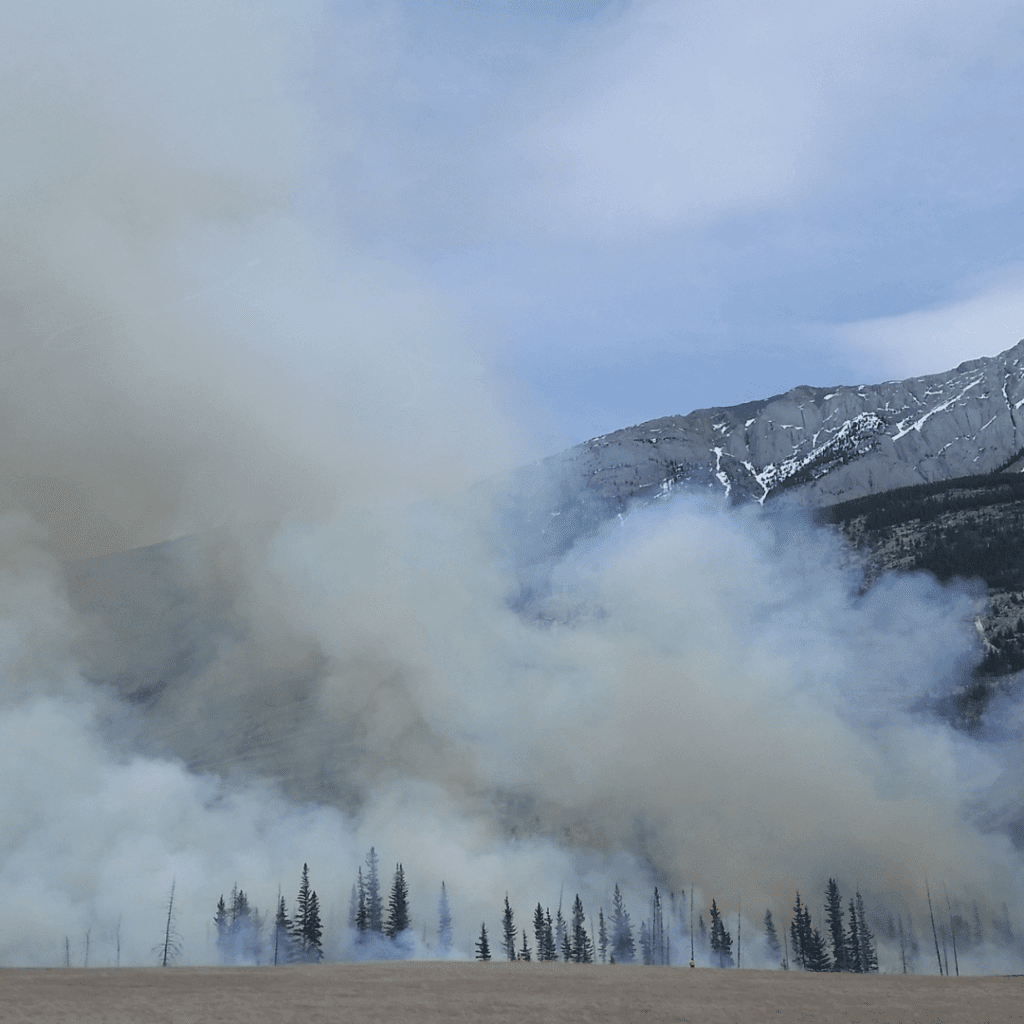
Impact on Air Quality and Health from Wildfire Smoke
Wildfire smoke is a complex mixture of visible and invisible particles and gases that are released during a wildfire. It is a byproduct of the burning of vegetation, trees, and other organic matter. Depending on the strength of the wind and other weather conditions, wildfire smoke can travel thousands of miles, affecting air quality in distant areas far removed from the actual fire.
Effects of Wildfire Smoke on Air Quality
Wildfire smoke can significantly degrade air quality, leading to reduced visibility and creating hazy conditions. The small particles in wildfire smoke, known as PM2.5, are small enough to penetrate deep into the lungs, causing respiratory problems. Wildfire smoke also contains harmful gases such as carbon monoxide, nitrogen oxides, and volatile organic compounds (VOCs). These pollutants can contribute to the formation of ground-level ozone and smog. Depending on weather conditions and the size of the fire, wildfire smoke can persist in the air for days or even weeks.
Health Impacts of Wildfire Smoke
Exposure to wildfire smoke can have various health effects, ranging from mild to severe. Short-term health effects include eye irritation, coughing, wheezing, shortness of breath, and exacerbation of existing respiratory conditions like asthma and bronchitis. People with heart or lung diseases, older people, children, and pregnant people are more susceptible to the health effects of wildfire smoke. Long-term exposure to wildfire smoke may increase the risk of developing chronic respiratory conditions, cardiovascular diseases, and even premature death. Research has shown that communities exposed to wildfire smoke experience higher rates of hospital admissions for respiratory and cardiovascular issues.
Protecting Yourself from Wildfire Smoke
There are several ways to protect yourself from wildfire smoke. Staying indoors and keeping windows and doors closed can help minimize exposure to outdoor air pollution. Using air purifiers with HEPA filters and maintaining indoor air as clean as possible can create a healthier indoor environment. Avoid activities that can increase indoor air pollution, such as smoking, using candles, or frying food. If you must go outside, wear N95 or P100 respirator mask to filter out fine particles. It is also important to follow local air quality alerts and guidelines provided by public health authorities.
Air Purifier That Protects Your Home Against Wildfire Smoke
- UV light for added smoke particle protection.
- Cleans air up to 1,600 square feet.
- HEPA filtration.
- Ultra quiet.
- Quality tested.
Long-Term Effects of Breathing in Wildfire Smoke
Studies have found that long-term exposure to wildfire smoke can lead to chronic respiratory diseases such as chronic bronchitis and reduced lung function. Children exposed to wildfire smoke may experience long-term effects on lung development and an increased risk of respiratory infections.
Moreover, wildfire smoke contains carcinogenic substances, and prolonged exposure may increase the risk of developing lung cancer. Regular check-ups and preventive measures are important to monitor and manage the long-term health effects of wildfire smoke exposure. Efforts to reduce greenhouse gas emissions and prevent wildfires can help mitigate the long-term impacts of wildfire smoke on public health.
Impact of Wildfire Smoke on Indoor Air Quality
Wildfire smoke can infiltrate indoor spaces through open windows, doors, and cracks. Using high-efficiency air filters in HVAC systems can help remove smoke particles from indoor air. Sealing gaps and cracks in windows and doors can help prevent smoke from entering the house. Running air purifiers with HEPA filters can further improve indoor air quality during wildfires. Keeping indoor humidity levels between 40-60% can help reduce the absorption of smoke particles into surfaces.
Travel Distance of Wildfire Smoke
Wildfire smoke can travel hundreds or even thousands of miles, depending on wind patterns and weather conditions. Large wildfires can emit smoke plumes that reach high altitudes and get carried by upper-level winds. Smoke from wildfires in one region or country can affect air quality in distant areas, including neighboring states or even countries. Factors such as the size and intensity of the fire, as well as atmospheric conditions, play a role in determining the travel distance of wildfire smoke. Monitoring and forecasting systems help track the movement of wildfire smoke and provide early warnings to affected areas.
Signs of Wildfire Smoke Affecting the Air
Visible signs of wildfire smoke include hazy skies, reduced visibility, and a distinct smell of smoke in the air. Health effects such as coughing, shortness of breath, and eye irritation may indicate that wildfire smoke is affecting the air quality in your area. Air quality monitoring stations provide real-time data on pollutant levels, including PM2.5, to help assess the impact of wildfire smoke. Local authorities often issue air quality advisories and recommendations during periods of high wildfire smoke activity. Keeping track of news updates and official announcements can help you stay informed about the air quality in your area.
Measures to Mitigate the Impact of Wildfire Smoke
Implementing effective wildfire management strategies to prevent and control wildfires can significantly reduce the amount of smoke produced. Public health agencies and emergency management organizations work together to provide timely information and guidance to the public during wildfires. Communities can establish clean air shelters or designated indoor spaces with air filtration systems to provide refuge from poor outdoor air quality. Research and technological advancements in smoke forecasting and modeling help improve preparedness and response efforts. Collaborative efforts between governments, organizations, and individuals are crucial to mitigate the impact of wildfire smoke on public health.
Conclusion
Wildfires can strike quickly, and there’s no room for hesitation when safety is on the line. The strategies in A Comprehensive Guide to Wildfire Survival: Best Ways to Survive are about giving you control, knowledge, and peace of mind. Preparing your home, knowing evacuation routes, and having the right gear ready can make all the difference. Remember, survival isn’t about panic—it’s about planning, awareness, and action. Take these steps now so when wildfire season arrives, you’re ready to protect yourself, your loved ones, and your property.
Learn how to protect yourself and your home from wildfire threats while strengthening your overall preparedness in The Complete Guide to Emergency Preparedness: Everything You Need to Thrive in Any Situation.
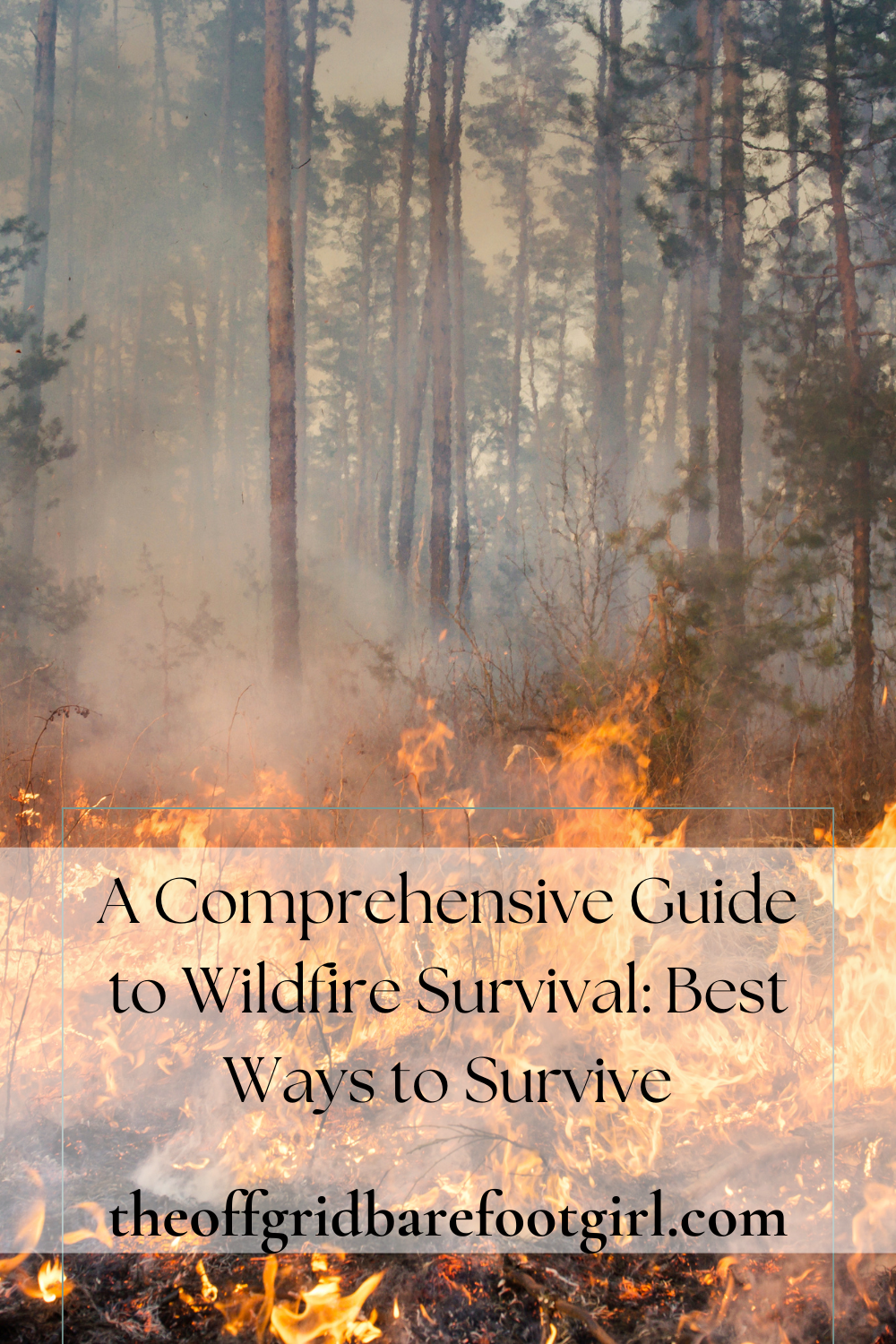
Frequently Asked Questions
1. How do I prepare my home for wildfire season?
Start by creating defensible space—clear dry brush, trim trees, and keep flammable materials away from your house. Fire-resistant landscaping and proper roof maintenance also reduce risk.
2. What should go in my wildfire emergency kit?
Include water, non-perishable food, first aid supplies, masks for smoke, flashlights, important documents, and a battery-powered radio. Don’t forget pet supplies if you have furry family members.
3. How do I know when to evacuate?
Follow local alerts and evacuation orders immediately. If smoke or fire is approaching, leave early—waiting until the last minute is the most dangerous choice.
4. Can I stay safe if I have no nearby shelter?
Yes, but you need a plan. Know multiple evacuation routes, identify nearby safe zones like community centers or friends’ homes, and always carry your emergency kit and supplies. Preparation is key.
Summary
I hope I have inspired you to live sustainably with these tips and products.
If you were encouraged by this post, I invite you to check out my FREE Printables Page for fun free printables, planners, and charts.
ENTER MY FREE Printables Page HERE
Here are some more of my gardening inspiration posts to check out!
How to Feed Your Family During the Government Shutdown
12 Best Tips for Creating an Eco-Friendly Household
Survival Lessons from the Great Depression
The Best 15 Homesteading Blogs to Follow for Inspiration
How to Criminal-Proof Your Home with These 5 Steps
How to Create Your Cottagecore Aesthetic Dream Home
Ideas for Rustic Living Room Vibes You’ll Love All Year Round!
How to Prep Your Home for Chilly Fall Nights
Bring Back the Magic of Fireflies and Lightning Bugs with Solar Power!
The Ultimate Portable Power Bank for Homesteaders and Preppers!
A Bug Out Bag That’s Actually Ready — When You Need It Most!
Magical Ways to Use Fairy Lights in Your Off-Grid Home
How to Live a Cozy Off-Grid Life
The Best Off-Grid Kitchen Tools for Indoors (No Power Needed!)
DIY Solar Made Simple: How I Powered My Off-Grid Life with Practical Preppers!
Sleeper Cells in America: What You Need to Know Now!
How People Are Surviving in Broken Cities with Broken Systems
When the World Hurts, We Prepare with Purpose
How to Live On Raw Land: Everything You Need to Know!
How to Do Off-Grid Laundry with Eco-Friendly Laundry Detergent!
Hollywood on Fire! What Secrets Are In the Ashes?
FEMA Concentration Camps? Are Echos of the Past Returning?
How Likely Is a Russian EMP? One Pulse Could Black Us Out!
What Dark Secrets Lie in The Bird Flu Symptoms?
The Blackout Sun: Who Is Blacking Out Our Sunlight?
More Posts!
How to Bug-In During a Deep Freeze!
‘FOGVID-24?’ What’s in the Mysterious Fog That’s Making Everyone Sick?
From Snow to Sow: Plan Your Spring Garden Now!
11 Fun Ways to Brighten Your Spring Garden with Personality
Top 10 Spring Garden Crops to Harvest in 30 Days and Eat Now!
The Best Survival Crops for Caloric Survival
More Posts!
My Victory Garden: What I Learned from 5+ Years
Why Every Family Should Have a Victory Garden in Their Backyard Now!
The Best Perennials for a Long-Term Survival Garden
The Best Essential Oils for Plants That Repel Garden Bugs
How to Grow Green Garden Peas: Perfect Plump Peas!
Hugelkultur: Does This Epic Pioneering Method Actually Work?
9 Ways to Celebrate Earthing Day in Your Garden!
Gardening Indoors: Secrets of Growing Your Food Inside!
How to DIY a Milk Jug Drip Irrigation System!
Why Cedar Mulch Is The Perfect Natural Weed Barrier
Gardening Projects
Onions: How to Grow Onions for Storage
Peas: How to Grow Garden Peas for a Bumper Crop
Carrots: How to Grow Carrots for a Bountiful Harvest
Prep Your Garden for Spring Planting with These Expert Tips!
How to Grow a Prepper Garden to Survive and Thrive
The Best Garden Tools You Need for a Productive Season
Fastest Growing Vegetables for Your Survival Garden
How to Grow Marigolds As Pest Control In Your Vegetable Garden
Must-Have Tools for a Successful Balcony Vegetable Garden
How to Effectively Combat Powdery Mildew in Your Garden
The Best Tips for Organic Gardening
How to Release Ladybugs In Your Garden for Organic Pest Control
More Posts!!
The Best Garden Snail Control Strategies
The Best Spring Vegetables to Grow in Your Garden
Seed Starter Mix: How To Make Your Organic Seed Starter Mix At Home
How to Grow a Productive Canning Garden
How to Plant and Grow a Salsa Garden
Easiest Heirloom Vegetable Seeds to Grow Now
How to Use the Hand Twist Claw Tiller: Tackling Tough Soil
More Fun Gardening Posts to Check Out!
Planning Your Garden: How to Plan a Vegetable Garden: Expert Green Thumb Tips!
Winterizing the Garden: How to Winterize Your Vegetable Garden: Step-by-Step Checklist
Mulching the Garden: How to Make Leaf Litter Mulch
Grow a Pumpkin Patch: How to Grow a Pumpkin Patch in Your Backyard
How to Grow a Fall Garden: 9 Best Fall Crops
Clever Ways to Incorporate Indoor Composting into Your Home
How to Start Composting for the Garden: A Step-by-Step Guide
The Ultimate Guide to Composting in Your Suburban Backyard
Why I Built A Survival Garden in My Backyard
16 Best Medicinal Herbs to Grow in Your Garden Now
Blessings,
The Off Grid Barefoot Girl





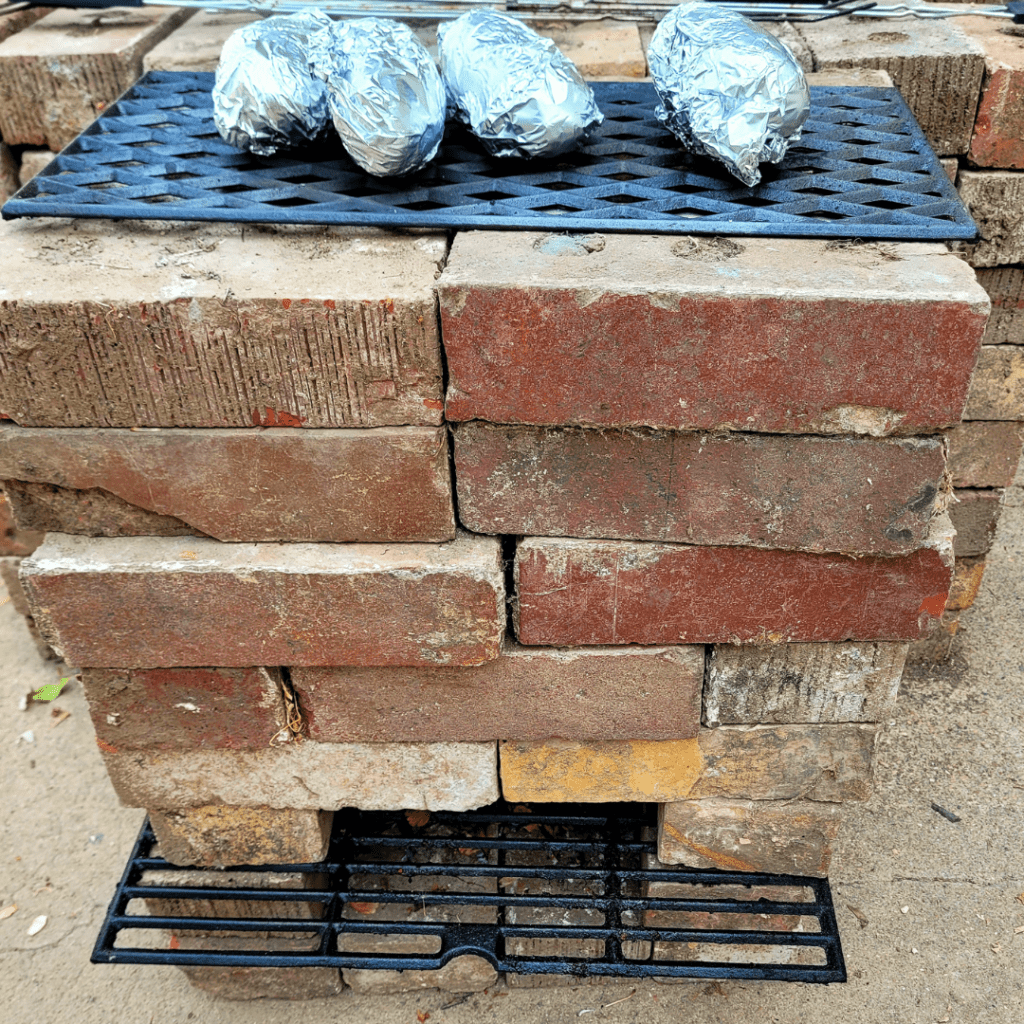
Best best best..